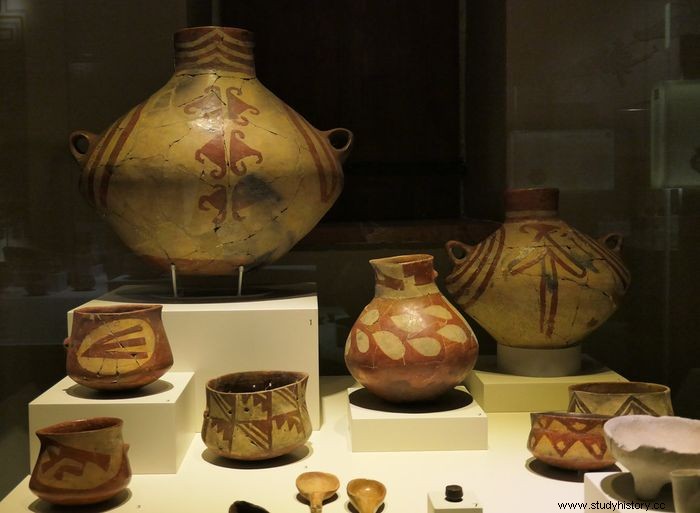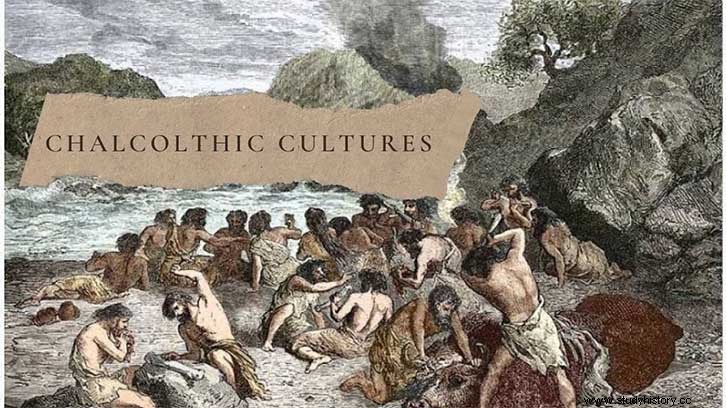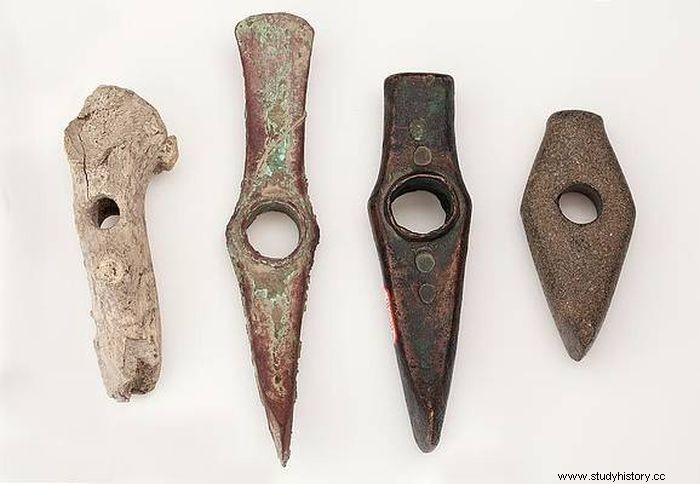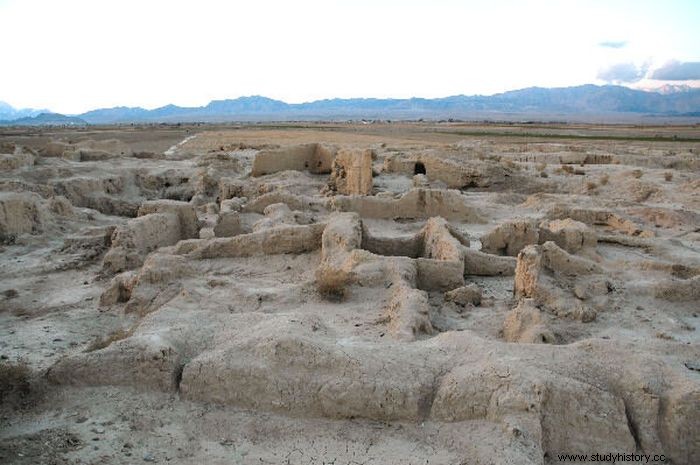Several cultures began to use metal after the end of the Neolithic period, primarily copper and low-grade bronze. Chalcolithic, meaning stone-copper phase, is a civilization of the use of copper and stone. It lasted from 2000 BC. to 700 BC. in India. This culture was most visible during the pre-Harappan period, although it was also present in a few places during the post-Harappan period. The majority of the population lived in rural areas among hills and rivers. The farming communities of Kayatha, Ahar or Banas, Malwa and Jorwe belong to the Chalcolithic civilization.
The Chalcolithic Age

The term Chalcolithic is derived from the Greek terms "khalkos" + "lthos", meaning "copper" and "stone", respectively, and refers to the copper age. The Eneolithic, often known as the Neolithic, is an archaeological phase that is commonly considered part of the Neolithic (although it was originally defined as a transition between the Neolithic and Bronze Ages).
Knives, axes, fishing hooks, rods and bronze tools were often used. These tools were made by combining tin and copper to form the bronze alloy. This alloy was often used to make tools and weapons during the Calcolitic era because it was tougher than copper.
The Chalcolithic Age was India's first metal age, and it saw the use of copper along with stone. It also became known as the stone-copper period. These people used low quality bronze to produce tools and weapons in addition to copper and stone. There are several settlements in chronological order. Between 2000 BC and 700 BC. the Chalcolithic culture consisted mostly of agricultural groups.
Characteristics of calculic age

Agriculture and animals
The Chalcolithic age lived on hunting, fishing and farming. Hunting was an important task. Sheep, buffaloes, goats, cattle and pigs were raised and killed for food (d) The remains of the camel have also been discovered. People ate beef, but no evidence of pork was found.
Cotton was grown on soil that was black cotton. There are also traces of rice planting. This suggests that they ate fish and rice. Rice was grown in the East Indies, while barley was grown in the West Indies. The primary crops grown include barley and wheat, lentils, bajra, jowar, rye millet, green pea and green and black gram. Knives, axes, fishing hooks, chisels, sticks and rods were all made of metals such as copper and their alloys.
Houses
The Chalcolithic people of Harappa used a lot of bricks, but there are no indications of burnt bricks. The homes were simple in design, either rectangular or round. People built houses mostly of mud with coatings of cow dung and lime. Although most homes had only one room, there were occasional multi-room houses. In the center of the settlement are huge mud buildings with five rooms, four rectangular and a round for powerful individuals. Furnaces and circular pit houses are found in Inamgaon.
Funerals
What may be a mortuary ceremonialism 'is one of the defining features of the late Neolithic and Copper Age. From the megalithic tombs on the edge of the Atlantic to the cemeteries in Southeastern Europe, the ceremonies are different. Nevertheless, the dead, who had a constant presence in society and regularly exist in places of exile, collective graves, settlement burials, family plots and cenotaphs in cemeteries, were a characteristic element of these cultures. These meetings took place in connection with ancestral honor and a sense of location and continuity in the connection. It confirmed the existence and continued existence of the household or hamlet to which the deceased belonged.
In the north-south direction, people buried the dead in the floor of the home, along with pots and copper objects. In Navas, there were funerals of children with copper ceramics or necklaces around their necks. These children came mostly from wealthy homes. Bodies with 29 bracelets and two unique axes were also found in the Kayatha region.
Arts and Crafts
The presence of painted pottery is a hallmark of the Chalcolithic age. In addition, the emergence of arts and crafts by people such as coppersmiths and stonemasons is an important feature of the Chalcolithic period.
Painted pottery was found in several places in India. During the Chalcolithic period, people used a variety of pottery. The black-red pottery of the Ahar people was one of the most common types, and was widely used among them. In the Chalcolithic period, there was considerable use of ocher-colored pottery. A notable feature of the Chalcolithic period is the existence of painted pottery.
People throughout the Calcutta period used many forms of pottery. Of all of them, the black-and-red pottery was popular. People also used Okre-Colored Pottery (OCP).
The Chalcolithic culture was popular for its wheeled pottery - mainly red and orange. It was ornamentation of ceramics with varied shapes and painted in linear designs, mostly in black. In addition, there was the use of floral, flora, animal and bird designs.
For the first time, there was also the production of black-red ceramics. Pots with canals, plate-on-stands and buns-on-stands were also found in Madhya Pradesh, Maharashtra and Bihar.
Coppersmiths, ivory carvers, lime makers and terracotta artists dominated the Calcutta era. There was the use of semi-precious stones and pearls such as agate, jasper, chalcedony and carnelian to make ornaments. Spinning and weaving were skills that people had. Flax, cotton and silk threads were discovered in Maharashtra.
The importance of the calculus phase

The Chalcolithic period spans the entire country, except for the alluvial area and dense forests, and most lived near hills and rivers. There was the use of microlitic tools of stone and copper. Humans were also perfect smelters, and it was the first time they used painted pottery. The majority of the pots were wheel black and crimson red. Cooking, storage, drinking and eating were in these pots. There is also evidence of the use of lota and thali.
It is Neolithic-Chalcolithic in some regions when the Neolithic phase passed to the Chalcolithic. The people of the Chalcolithic era were colonizers, and the most important foods were fish and rice.
Chalcolithioc Phase Limitations
Chalcolithic humans could not fully exploit livestock since they only used them for food and not milk (they thought milk was only for young animals). In addition, they did not do much gardening. They lived in an area with black cotton soil, which necessitated the use of iron tools for cultivation, and there were no signs of plowing or chopping.
The calculus phase was an extremely short phase of life. There are signs of a large number of buried young people, which indicates malnutrition and epidemic outbreaks. Since people did not know how to combine two metals, they could not effectively use the stronger metal bronze. Copper had its own set of limits and a limited supply. Because people were unaware of the writing technique, they could not benefit from the technical expertise of the Indus people.
Calculitic age worldwide

Chalcolithic age in the east
The fertile crescent may have been the first place where metallurgy appeared. A bracelet from the 6th millennium BC. appeared from Yarim Tepe in northern Iraq, and a somewhat later conical piece of lead from the Halaf era Arpachiyah, near Mosul, is the earliest lead finds (Pb) in the ancient Near East. Due to the lack of natural lead, such objects raise the hypothesis that lead smelting began before copper smelting.
Copper smelting also finds its mention in this place at the same time (shortly after 6000 BC), although the use of lead seems to come first. Early metalworking also testifies to the nearby Tell Maghzaliyah site, which appears to be significantly older and has no evidence of pottery.
Middle East
Copper mining was evident in Timnadalen between 7000 and 5000 BC. In archaeological stone tool compilations from the Middle East, the transition from Neolithic to Chalcolithic is characterized by a decline in the purchase and use of high-quality raw materials. This significant transformation exists throughout the region, especially on Iran's Tehran plain. An examination of six archaeological sites revealed a clearly declining trend in lithic artefact material quality and aesthetic variance. These findings are in use by Fazeli et al. as evidence of the loss of specialization in the craft caused by the increased use of copper tools.
The results from the Tehran plain show how copper working methods affected the local systems of professionals in lithic crafts and raw materials. By the Middle Calcutta (ca. 4500–3500 BC), networks of exchange and processing and production that developed through the Neolithic seem to be collapsing. It was replaced by using local materials with a predominant household fabrication of stone tools.
Chalcolithic age in Europe
The oldest correctly dated evidence of copper production comes from a Serbian archeological site dating back about 7,500 years ago. The discovery in June 2010 adds around 800 years to the known history of copper smelting. This means that the invention of copper smelting in several places in Asia and Europe at that time instead of spreading from a single source.
A copper ax was found in Prokuplje, Serbia, indicating that the metal was used in Europe about 7,500 years ago (5500 BC). It was much earlier than people previously thought. The application of copper metal was more popular than the metal itself. Stone axes modeled on copper axes were in use in the European battle ax culture, even with casting etched into the stone. A Mondsee copper ax with the iceman tzi was found. The discovery was in the tztal alps in 1991 and the remains date back to around 3300 BC
Remarkable culture
Vila Nova de So Pedro and Los Millares are examples of Chalcolithic cultures on the Iberian Peninsula. Goblet pottery was discovered in both places, which dates back several centuries after the copper work began. Copper and bronze technology, as well as Indo-European languages, seem to have spread across Europe due to the Beaker culture. Copper has been used in Britain during the 25th and 22nd centuries BC. However, some archaeologists do not recognize a British Chalcolithic because of the small scale of production and use.
Calculite age in South AsiaCeramic parallels between the civilization of the Indus Valley, southern Turkmenistan and northern Iran during the Chalcolithic period (4300–3300 BC) show extensive mobility and trade, according to Parpola (2005). The word "calcolitic" also applies to the Stone Age in South Asia. For example, copper bracelets and arrowheads were found in Bhirrana, the earliest Indus site of civilization.
Between 7000 and 3300 BC. made the people of Mehrgarh in today's Pakistan utensils of local copper ore. A pottery factory in the province of Balochistan, Pakistan, uncovered 12 leaves or leaf fragments in the Nausharo area, dating back 4,500 years. These leaves have a length of 12–18 cm (5–7 inches), a width of 1.2–2.0 cm (0.5–0.8 inches), and are relatively thin. According to archaeological evidence, these blades were formed using a copper indentation and served as a pottery tool for trimming and shaping unfired pottery. In addition, a petrographic study confirms the presence of a few exotic black-slid ceramic objects from the Indus Valley and local ceramic production.
Calculite age in pre-Columbian AmericaCopper smelting was originally invented independently of Andean civilizations in South America. The word "Calcolithic" is used to describe American civilizations that had used copper and copper alloys for thousands of years before the arrival of Europeans. Headquartered in the Upper Great Lakes region, present-day Michigan and Wisconsin in the United States, The Old Copper Complex extracted and produced copper as a tool, weapon, and personal adornment, as well as cultures in the Andes and Meso-America.
The evidence for smelting or alloying finds in North America is controversial, and archaeologists often assume that artefacts were cold-formed. However, some of the artefacts from these sites date to 4000-1000 BC, making them some of the oldest calculus sites in the world. Furthermore, some archaeologists believe that the archaeological journal contains artifacts and structural evidence of the casting of Hopewell and Mississippi peoples.
Calculite age in East AsiaCopper objects first appeared in East Asia in the 5th millennium BC, for example in the Jiangzhai and Hongshan cultures. However, they were not much in use. Although copper objects may appear early, they do not indicate a common practice of copper metallurgy in East Asia, beginning with the entry of the Afanasievo tribes into western Mongolia towards the end of the fourth millennium, the beginning of the third millennium BC. P> Calculite age in sub-Saharan Africa
Between 3000 and 2500 BC. Independent copper smelting occurred in the Ar mountains of Niger. There was no full development of the technique, which showed that melting was not a new concept. It reached maturity around 1500 BC
the conclusion
During the Chalcolithic period, there was a significant change in lifestyle and tool making. The presence of painted pottery and the burial of the deceased in a particular direction are two notable elements in the Chalcolithic period. During the same historical period, several bronze tools were found. The calculus period was central to the development of tool making and transportation.
